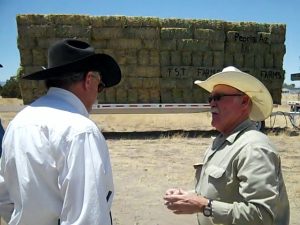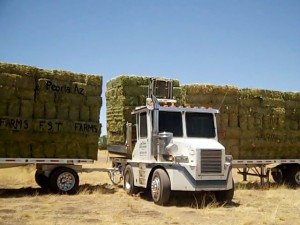Short and Long-Term Impact of the State’s Wildfire’s on Arizona’s Cattle still to be determined.
By Philip Bashaw, Arizona Farm Bureau with Contributions by Liz Foster and Julie Murphree, Arizona Farm Bureau
In the wake of the largest wildfire in Arizona’s history and several other wildfires around the state, the farming and ranching communities are coming together to care for livestock displaced by a summer season of Arizona wildfires like no other. Once it became evident the Wallow Fire in northern Arizona was burning out of control and putting area agriculture at risk, Arizona Farm Bureau leapt into action to gather resources to care for livestock.

Livestock inspector Zeke Austin (left) and Rancher Dennis Stacey discuss coordination of the hay delivery effort taking place throughout Arizona. Ranch families are facing major feed issues with their cattle displaced by Arizona’s raging wildfires.
By mid June, the Wallow Fire had officially topped a half-million acres, making it the largest wildfire in the state’s history surpassing the Rodeo-Chediski Fire, which burned nearly 470,000 acres near Show Low in 2002. The Wallow Fire reached a cost of $30 million by June 14th. And another fire emerging as one of Arizona’s top five is also burning in southeastern Arizona. Though now more than 70% contained, the Horseshoe Two Fire in Cochise County started May 8th and has already cost the state $28 million. Just recently begun, the Monument Fire in southern Arizona is also sparking area concern as acres and houses continue to burn.
For affected Arizona ranchers representing a $3.5 billion industry in the state, the fires mean short- and long-term concerns for cattle that no longer have summer pasture to graze on. For Arizona families, this should be of concern at this billion dollar industry in Arizona could experience an obvious impact on just the cash value of the beef herd, which was $600 million in 2009, according to the United States Department of Agriculture (USDA). Tough times in the beef industry could mean even higher meat prices at the check-out counter.
Farmers and Ranchers Banding Together Bring Hay to Cattle
Several truckloads of hay were delivered to Springerville to help the ranchers displaced by the Wallow Fire. Partnered with the Arizona Department of Agriculture (ADA), Arizona Farm Bureau and an army of volunteers distributed needed hay to the appropriate recipients when the shipments arrived at Springerville’s baseball fields. Serving a critical role, ADA livestock inspectors checked hay requests with a list of grazing allotments in the area to ensure the hay was distributed fairly among the area ranchers.
Whitney Wiltbank with the Sprucedale Guest Ranch is one of the ranchers impacted by the Wallow fire. “We are struggling here this season,” he says. “We have been here for 70 years. This hay is absolutely a blessing and we are so thankful for the farmers and their generosity.”
A portion of that hay went to several Arizona ranch families that were attempting to feed more than 250 cows and approximately 50 head of other livestock in the vicinity of Blue, Arizona. These ranchers were forced to drive their cattle south out of their normal summer allotments back down to feed on winter range and private land. That left very little feed to support the number of cattle that would normally be on summer pastures.
Rancher Justin Marks and his family run cattle in Blue. “We can’t express enough our gratitude to these people for getting us this hay,” says Marks. “It’s incredible that folks are so concerned about us. We hope someday we can pay them back. It’s an answer to many prayers.”
Farmers from all over Arizona donated their time, trucks and

Loads of donated hay with a delivered value of $6,000 each are shipping all over the state to areas impacted by this summer’s wildfires for displaced livestock. Aggies helping Aggies means agriculture supports its own during a crisis.
hay to help ranchers with the immediate needs of the livestock.
ADA Livestock Inspector Zeke Austin says the hay is a lifesaver for the ranchers. “This can be nothing but great for these guys since their meadows their country is burned up. Having talked to them, I can say they appreciate everything that is coming their way.”
The Long-term Impact
Sprucedale Guest Ranch’s Wiltbank, a Farm Bureau member, recalls the Wallow Fire evacuation. “The fire was eight miles away from us and it plumed and came down and jumped to our doorstep in an hour,” he explains. “They gave us 30 minutes to evacuate. We had to push 60 head of horses out into a pasture and open all the gates and hope for the best. Then the fire went right through that pasture. They all ran away from the fire and made it back to safety.”
Though the immediate drama of escaping a raging wildfire will never be forgotten, the long-term impact of such an event will also not be forgotten for some time.
Because many of the allotments that have burned are summer pastures, the cattle now have nowhere to go through the summer months until allotments can be opened for grazing again. This could be at least two years, according to Forrest Service regulations. Many of the ranchers north of the fire had not yet moved their cattle to the summer pastures now destroyed by fire. Those pastures typically open July 15th.
Dennis Stacey, local rancher on the Blue, sees a challenging time ahead based on what has now burned and where ranchers’ grazing and feeding options exist. “Our winter country is on fire,” he explains. “I don’t know how much of that is going to be left on the Blue. Our summer country already burned.”
Despite this, Stacey operates in the tradition of the optimist and is grateful for the hay donations. “Thank you to the farm folks who are helping us out,” he says. “It means a lot. We are an old-time ranching family and we’re going to stay in the cow business if at all possible. Too much manure in my bloodstream. This fire is a tragedy. But it’s good to see the agriculture community (farmers and ranchers) coming together in a tragic situation. We just want to say thank you to the farmers.”
Arizona Farm Bureau board member and Navajo County Farm Bureau President Ethan Ellsworth says the National Forest Service has been gracious enough to open up some of the riparian areas to let cattle feed, but environmentalists are already causing a stink about it over a minnow that lives in the Blue. “It’s really frustrating to hear about this kind of reaction when you have cattle and ranch families struggling to survive these fires,” says Ellsworth.
Ellsworth also indicated that most of the ranch families don’t have the option of selling off the herd and starting over later. “If that’s their only option; it will put them out of business.”
The Arizona Farm Bureau will continue to coordinate donations to assist the ranchers around the state impacted by wildfires. Hay donations are required even after the fires are extinguished and the Farm Bureau will be attempting to address some of those needs throughout the summer.
Arizona Farm Bureau President Kevin Rogers says, “In the face of a tragedy such as these wildfires, we have to do what we need to do to help our friends in the agricultural industry. It is incredible to see the agricultural industry come together to help our friends in need.”
One thing is evident. The feed challenges to displaced livestock during Arizona’s 2011 wildfires will not end overnight. Weather has not cooperated, with high winds and relative-humidity levels in the single digits. This issue could have long-term consequences for Arizona ranchers.
Despite this, the agriculture community appears poised to help make a difference. To date, Arizona hay farmers donated an estimated $150,000 to $200,000 in hay for Arizona cattle.
Editor’s note: For more information on how to help or where to donate contact Liz Foster at480.276.7442. To make a monetary donation make checks payable to Arizona Farm Bureau Federation, Wildfire Relief and send your checks to 325 S. Higley Rd. Suite 210 Gilbert, AZ 85296. Donations to the Arizona Farm Bureau for wildfire relief are not tax deductible.
Related articles
- Arizona Food Prices Continue to Rise; 7% Above First Quarter 2011 (fillyourplate.org)
- It’s Time Agriculture Takes Back ‘Sustainable’ (fillyourplate.org)
- Modern-Day Farms: “A Billion Acts of Green” (fillyourplate.org)



Pingback: Join us at Fossil Creek Creamery on September 4th! | Fill Your Plate Blog
Pingback: Three Acres and a Cow- Random Musings for a Monday Morning! | Fill Your Plate Blog